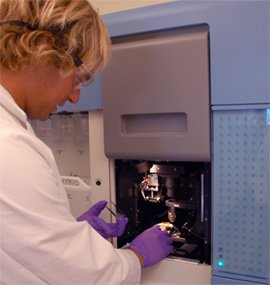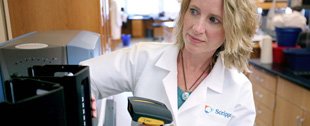Home » Translational Research » Research Highlights » Cancer » Here
In this section
Human Tumor Sequencing
 The DNA fragments bound to the inside surfaces of the flow-cell will be synthesized and imaged with the advanced sequencing equipment in STSI’s labs. Because a single flow-cell contains eight lanes, eight separate samples can be sequenced simultaneously. A flow-cell can generate up to 150 billion base pairs, providing scientists with 50x coverage of the human genome.
The DNA fragments bound to the inside surfaces of the flow-cell will be synthesized and imaged with the advanced sequencing equipment in STSI’s labs. Because a single flow-cell contains eight lanes, eight separate samples can be sequenced simultaneously. A flow-cell can generate up to 150 billion base pairs, providing scientists with 50x coverage of the human genome.
Identifying associations between patient’s DNA and response to cancer therapy
A newly diagnosed cancer patient’s prognosis and treatment plan today are primarily guided by the stage and grade of the patient’s primary tumor. In the future, molecular diagnosis will be a hallmark oncogenic capability for each tumor, as important as stage and grade and will allow physicians to tailor the prognosis and therapy according to the genetic profile of each patient’s tumor.
To accelerate the pace of research needed to provide the cancer genomics knowledge needed for the accurate diagnosis of oncogenic cells and tissues, the Scripps Translational Science Institute (STSI) established the Human Tumor Sequencing (HUTS) project under the leadership of Samuel Levy, Ph.D., the institute’s Director of Genome Sciences.
Scientific knowledge about oncogenic mutations is incomplete because cancer is so genetically complex. Identical DNA mutations do not characterize the tumors of people who have the same cancer. Research thus far indicates that even within a single patient’s tumor, the malignant cells genetically differ, and relatively few of these mutations drive the tumor’s growth.
Dr. Levy and his collaborators at STSI, The Scripps Research Institute (TSRI) and Scripps Clinic are consistently sampling each tumor under investigation in the HUTS project so that they can define the heterogeneity of mutations within each mass. For example, in their investigation of a stage IIIC colon adenocarcinoma in a 40-year-old male patient, Dr. Levy and his colleagues analyzed samples not just from one randomly selected site in the mass, but from different anatomic areas such as epicenter, invading edge, and tumor-to-normal tissue transition.
Using a genomics based approach, Dr. Levy and his colleagues characterized gene-based mutational events common and unique to each anatomic locus in the colon cancer. To understand how a precise molecular characterization of events within a single tumor is influenced by the tumor’s heterogeneity, Levy and his colleagues developed a methodology that measured and established the relationship between changes in the exome in relation to tumor locus.
At the American Society of Human Genetics 2010 annual meeting, Dr. Levy and his collaborators reported that as much as 55% of the damaging point mutations that characterized the colon cancer differed among the distinct loci, and that seven to 20% of the point mutations at each of the loci were unique to either the epicenter, transition, luminal surface, deepest invasion and metastatic lymph areas. A total of 27% of all mutations detected in the tumor were common to all five loci.
Dr. Levy’s collaborators in the research presented at the ASHG conference included Glenn Oliveira, Andrew Carson, Ph.D., and Ali Torkamani, Ph.D., of STSI; Kelly Bethel, M.D., of Scripps Clinic; and Peter Kuhn, Ph.D., of TSRI.
 Glenn Olveira inserts the flow-cell containing DNA fragments into a sequencer at STSI/SGM.
Glenn Olveira inserts the flow-cell containing DNA fragments into a sequencer at STSI/SGM.
“N-of-1”
With each cancer patient who volunteers for HUTS, STSI’s approach is “N-of-1”: the patient is monitored as if he/she is participating in a clinical trial evaluating each of the therapeutic regimens prescribed by the patient’s oncologist as part of the process to define the optimal treatment strategy.
However, unlike a conventional clinical trial, the “N-of-1” approach searches for associations between a patient’s genetic factors and the effectiveness and safety of each prescribed therapy.
If biomarkers useful in predicting disease progression or response to therapeutics are identified, STSI scientists collaborate with the patient’s oncologist to help interpret the results.
STSI’s genomic analysis of each tumor is shared with the patient and his/her physician, with the understanding that the likelihood that the findings will directly benefit the patient now is minimal. It will be future patients for whom the research will have the most impact.
For more information:
“Research findings about genomic heterogeneity in colon cancer presented at ASHG annual meeting”
In the scientific journal Cancer Research, STSI scientists in 2008 described a method of predicting driver cancer cell mutations in protein kinases
“Scripps Health Begins Pioneering Study of Human Tumor Sequencing in Cancer Patients,” Feb. 17, 2010 news release.
